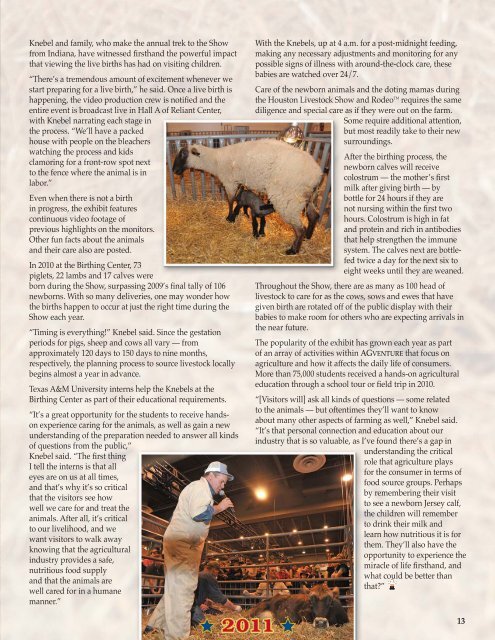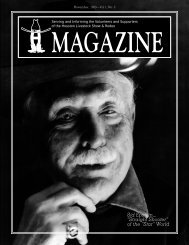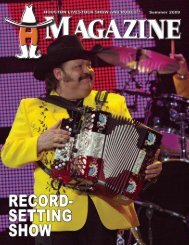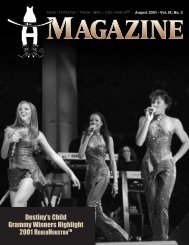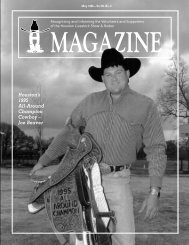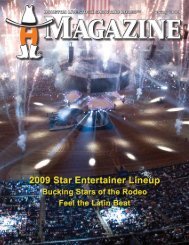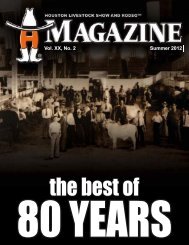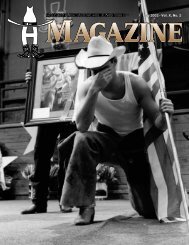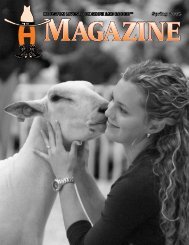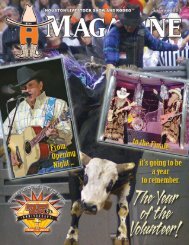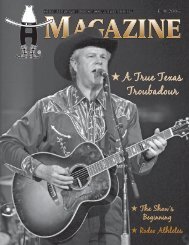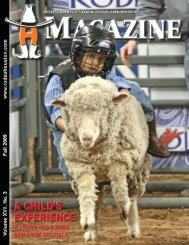trailblazer - Houston Livestock Show and Rodeo
trailblazer - Houston Livestock Show and Rodeo
trailblazer - Houston Livestock Show and Rodeo
You also want an ePaper? Increase the reach of your titles
YUMPU automatically turns print PDFs into web optimized ePapers that Google loves.
Knebel <strong>and</strong> family, who make the annual trek to the <strong>Show</strong><br />
from Indiana, have witnessed firsth<strong>and</strong> the powerful impact<br />
that viewing the live births has had on visiting children.<br />
“There’s a tremendous amount of excitement whenever we<br />
start preparing for a live birth,” he said. Once a live birth is<br />
happening, the video production crew is notified <strong>and</strong> the<br />
entire event is broadcast live in Hall A of Reliant Center,<br />
with Knebel narrating each stage in<br />
the process. “We’ll have a packed<br />
house with people on the bleachers<br />
watching the process <strong>and</strong> kids<br />
clamoring for a front-row spot next<br />
to the fence where the animal is in<br />
labor.”<br />
Even when there is not a birth<br />
in progress, the exhibit features<br />
continuous video footage of<br />
previous highlights on the monitors.<br />
Other fun facts about the animals<br />
<strong>and</strong> their care also are posted.<br />
In 2010 at the Birthing Center, 73<br />
piglets, 22 lambs <strong>and</strong> 17 calves were<br />
born during the <strong>Show</strong>, surpassing 2009’s final tally of 106<br />
newborns. With so many deliveries, one may wonder how<br />
the births happen to occur at just the right time during the<br />
<strong>Show</strong> each year.<br />
“Timing is everything!” Knebel said. Since the gestation<br />
periods for pigs, sheep <strong>and</strong> cows all vary — from<br />
approximately 120 days to 150 days to nine months,<br />
respectively, the planning process to source livestock locally<br />
begins almost a year in advance.<br />
Texas A&M University interns help the Knebels at the<br />
Birthing Center as part of their educational requirements.<br />
“It’s a great opportunity for the students to receive h<strong>and</strong>son<br />
experience caring for the animals, as well as gain a new<br />
underst<strong>and</strong>ing of the preparation needed to answer all kinds<br />
of questions from the public,”<br />
Knebel said. “The first thing<br />
I tell the interns is that all<br />
eyes are on us at all times,<br />
<strong>and</strong> that’s why it’s so critical<br />
that the visitors see how<br />
well we care for <strong>and</strong> treat the<br />
animals. After all, it’s critical<br />
to our livelihood, <strong>and</strong> we<br />
want visitors to walk away<br />
knowing that the agricultural<br />
industry provides a safe,<br />
nutritious food supply<br />
<strong>and</strong> that the animals are<br />
well cared for in a humane<br />
manner.”<br />
With the Knebels, up at 4 a.m. for a post-midnight feeding,<br />
making any necessary adjustments <strong>and</strong> monitoring for any<br />
possible signs of illness with around-the-clock care, these<br />
babies are watched over 24/7.<br />
Care of the newborn animals <strong>and</strong> the doting mamas during<br />
the <strong>Houston</strong> <strong>Livestock</strong> <strong>Show</strong> <strong>and</strong> <strong>Rodeo</strong> TM requires the same<br />
diligence <strong>and</strong> special care as if they were out on the farm.<br />
Some require additional attention,<br />
but most readily take to their new<br />
surroundings.<br />
After the birthing process, the<br />
newborn calves will receive<br />
colostrum — the mother’s first<br />
milk after giving birth — by<br />
bottle for 24 hours if they are<br />
not nursing within the first two<br />
hours. Colostrum is high in fat<br />
<strong>and</strong> protein <strong>and</strong> rich in antibodies<br />
that help strengthen the immune<br />
system. The calves next are bottlefed<br />
twice a day for the next six to<br />
eight weeks until they are weaned.<br />
Throughout the <strong>Show</strong>, there are as many as 100 head of<br />
livestock to care for as the cows, sows <strong>and</strong> ewes that have<br />
given birth are rotated off of the public display with their<br />
babies to make room for others who are expecting arrivals in<br />
the near future.<br />
The popularity of the exhibit has grown each year as part<br />
of an array of activities within AGVENTURE that focus on<br />
agriculture <strong>and</strong> how it affects the daily life of consumers.<br />
More than 75,000 students received a h<strong>and</strong>s-on agricultural<br />
education through a school tour or field trip in 2010.<br />
“[Visitors will] ask all kinds of questions — some related<br />
to the animals — but oftentimes they’ll want to know<br />
about many other aspects of farming as well,” Knebel said.<br />
“It’s that personal connection <strong>and</strong> education about our<br />
industry that is so valuable, as I’ve found there’s a gap in<br />
underst<strong>and</strong>ing the critical<br />
role that agriculture plays<br />
for the consumer in terms of<br />
food source groups. Perhaps<br />
by remembering their visit<br />
to see a newborn Jersey calf,<br />
the children will remember<br />
to drink their milk <strong>and</strong><br />
learn how nutritious it is for<br />
them. They’ll also have the<br />
opportunity to experience the<br />
miracle of life firsth<strong>and</strong>, <strong>and</strong><br />
what could be better than<br />
that?”<br />
13


